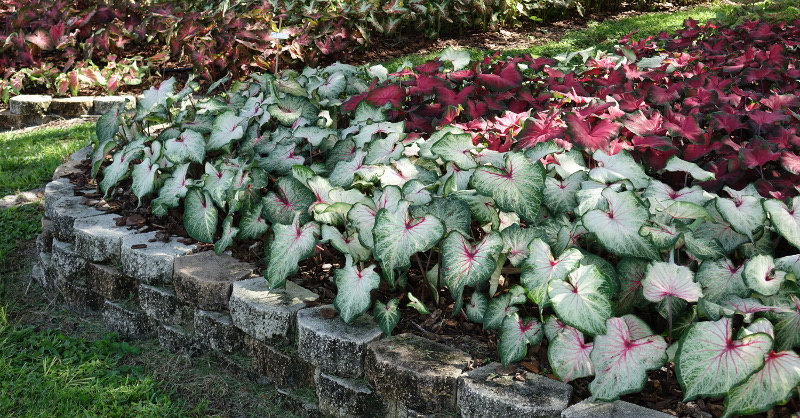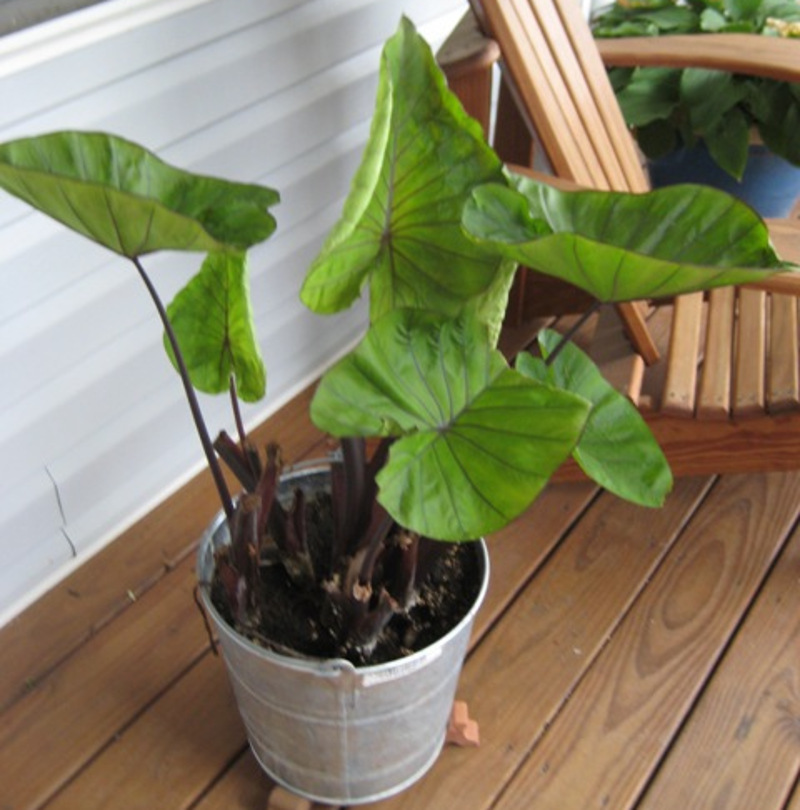Elephant ears, often referred to as colocasia, alocasia or caladiums. All of these are large leafed tropical plants grown for their striking foliage. Knowing which type of elephant ear you have is important because each type requires different growing conditions. If you are unsure of what type of elephant ear you have, it is safe to assume it's a caladium.
| Elephant Ear Types | |||
| Colocasia | Alocasia | Caladium | |
| Leaf Shape | Heart shaped leaves that point downwards | Pointed leaves with the tip facing upwards | Much Smaller |
| Sunlight | Full Sun | Partial Sun | Full Shade to Partial Shade |
| Moisture | Consistent moisture | Well drained soil | Watered weekly |
| Height | Up to 8 feet tall | Up to 6 feet tall | Up to 2 feet tall |
| Growing Zones | Zone 8-12 | Zones 10-11 | Zones 9-10 |
As you can see in the chart above, some elephant ears require different sunlight and grow to different sizes than others. So when planning where to plant elephant ears, it is important to try and figure out the ideal spot to ensure healthy and thriving plants.
Elephant ears are mostly native to Southeastern Asia in tropical and subtropical regions. Because the plants are not cold hardy in most regions, most gardeners grow these plants as annuals or dig up the bulbs before the first frost and store the tubers inside over the winter.

What You Need To Plant Elephant Ears
To plant elephant ears, pick out the perfect location based on the plant’s needs and the design you are hoping for. All you will need is a shovel or garden spade, some mulch and water. One other thing to ensure is that the threat of frost is over. You can add manure or other organic material to the soil to provide more nutrients, but that isn’t required.
Where to Plant Elephant Ears
This is where it’s important to know what type of elephant ear you have. More than likely a location that gets partial sun to full sun (over 5 hours of direct sunlight) is going to be the best location. If you have caladiums, the location should get partial shade to full shade (less than 4 hours of direct sunlight). Elephant ears like nutrient rich but well draining soil.
Dig small holes 3 inches deep and bury the tubers or bulbs, blunt side down. If you have elephant ears that are already growing (either from the nursery or that were started indoors), the hole will need to be 25-50% larger than the root ball, and the same depth. The top of the root ball should be planted level with the native dirt. Once the bulbs or plants are in the ground and the soil has covered the bulbs or root balls, apply a layer of mulch around the plants. Then water in deep to help encourage the plants to start getting established.

Elephant Ear Plant Spacing
When planting multiple elephant ear plants, space the plants at least the same width as the mature size. So if the mature elephant ear plant gets up to 4 feet wide, space the bulbs or young plants at least 4 feet apart, center on center (space between the holes you dig). This also is true around other plants and structures. You want to provide enough space for the plants to grow large and healthy. This ensures the plants have enough room for their roots to grow, gets enough nutrients in the soil and provides enough air circulation around the plants.
If you plan to grow the elephant ears in a garden planter, be sure to choose a large planter that has a sturdy base. These plants can get very large and heavy and will catch the wind with their large leaves. So the container needs to be sturdy enough to not fall over and also provide enough room for the roots to grow.

Steps To Plant Elephant Ears
Step 1 - determine which type of elephant ear you have
Step 2 - pick out the perfect location for the plant
Step 3 - plant bulbs 3 inches deep
Step 4 - cover with a layer of mulch
Step 5 - water deeply at least once a week
When to Plant Elephant Ears
Elephant ears cannot survive frost, so make sure the threat of frost is gone before planting. The last frost date by the growing zone you live in, is the best guidance to follow to be safe. The nighttime temperatures should be consistently 50-60 degrees Fahrenheit. If you don’t want to wait that long, you can start growing the bulbs indoors ahead of time in the late winter to give the plants a head start.
You can plant elephant ears all throughout the summer all the way up until 8 weeks before the last frost date. Again, use your growing zone to determine this, but it is generally in late October or early November. This will ensure the plant has enough time to go through its growing cycle before going dormant again.
If you are planting elephant ears that are already growing leaves, try to plant either in the morning or evening to reduce the amount of stress on the plants. We also recommend providing more water the first few weeks to help the plants get established.

Transplanting Elephant Ears
When moving elephant ears from one location to another, the goal should be to reduce the amount of stress the plants go through. The main ways to stress a plant out are cutting through the roots, moving the plants during the middle of the day during very hot days, or changing the temperature of the plants drastically from moving indoors to outdoors. Also, try to never let the roots dry out and don’t allow the bulbs to remain wet during the winter.
Bringing Elephant Plants From Indoors To Outdoors
If you start the bulbs indoors to get a head start, it is important to not stress the plants too much or they may go into shock. This typically happens when the temperatures from inside are drastically different than outside. Consistent temperatures in the 65-80 degree range outdoors is the best time to transplant the young plants outdoors.
Changing Locations Of Already Actively Growing Plants in the Summer
If you have a change of heart on where you want to grow the elephant ears, or the plants have outgrown the location or container they are in, you can transplant anytime throughout the summer. We recommend doing this in the early morning or evening to reduce the stress on the plant. Dig up the plant’s root ball as gently as you can, and follow the same planting instructions above for planting elephant ears that are already actively growing. Apply a lot of water once the plant has been moved to the new location.
Bringing Elephant Ear Bulbs Indoors For the Winter
This is a fairly easy process. Wait until the first frost, then cut the stems to around 6 inches tall. Dig up the tubers (bulbs) and place in a container. Cover the bulbs with soil and apply some moisture to the bulbs. You don’t want to soak the bulbs or keep them wet. But the bulbs should stay moist. Store the bulbs in a cool dark place throughout the winter until it's time to plant again once the threat of frost is gone in the spring.
Elephant Ears For Sale
 |
Author Chris Link - Published 09-09-2021 |
